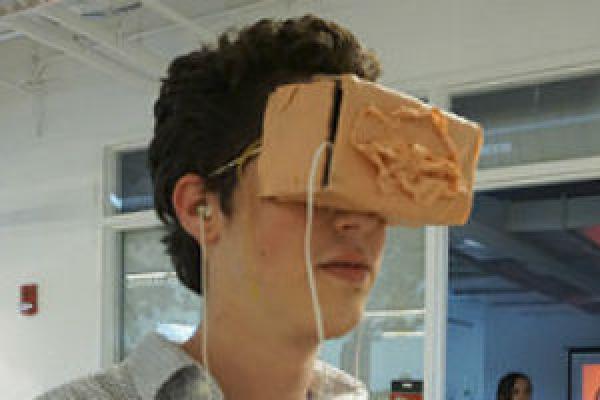Poindexter Village Brought Back to Life with Virtual Reality Technology


The project, a collaboration headed by Professor Ken Rinaldo in the Department of Art (pictured left) and Associate Professor David Staley in the Department of History, aims to recreate Poindexter Village, a former public housing development that was almost completely demolished in 2013.
“The Poindexter virtual reality program will be an immersive and emotionally engaged interactive experience that tells the history of an important neighborhood that gave rise to prominent artists and musicians such as Aminah Robinson,” said Rinaldo.
Rinaldo and his art and technology students are using Cinema 4D and Maya 3-D-modeling programs to bring digital assets (custom 3D models) into the Unity Game engine to recreate the village. Characters and sound with professional narration along with Unity coding will be added; the finished product will be featured in the Center of Science and Industry (COSI) for one year. Viewers will experience the work primarily through Google Cardboard with smartphones.
To begin their journey, the user will put on the Google Cardboard headset. They will then “walk” along a set path through Poindexter Village, listening to narratives and oral histories about their surroundings as they progress though time and the building of the village itself. Conditions, struggles and community life will be highlighted through the audio narratives. The program will begin in black and white and progress through to color as the interactor progresses from the 1940s to 1960s, when the village was booming. The team hopes to include several human characters outside the digitally reconstructed buildings and would like to reconstruct the inside of one of the apartments.
Poindexter Village, named for Rev. James Poindexter, located just east of Ohio State University Hospital East between Mt. Vernon Ave. and E. Long St., was built in 1940 as one of the first public housing projects in the United States. Poindexter became the heart of the African American community in Columbus for 20 to 30 years. It was a vibrant community full of life, home to people of all income levels.
In the mid-1950s, integration gave upper-class members the opportunity to move out of Poindexter Village. Urban renewal and the interstate freeway system cut the neighborhood off from the city, and as the middle and upper classes continued to move out, the village degraded further. In the 1960s a large swath of housing was torn down, and in 2013 it was almost completely demolished.
To capitalize on Poindexter’s proximity to the city, two high-rise apartments and a senior-citizen complex are planned. Some of the few remaining buildings may be turned into a museum to African American culture and the urban experience.
To compromise on the loss of culture that existed in Poindexter Village, the city of Columbus and the Columbus Metropolitan Housing Authority (CMHA) agreed to a historic remembrance project, which includes the exhibit at COSI, where the Poindexter virtual reality project will be hosted.

left: Pointdexter Village, circa 1940; right: Poindexter Village rendering
“Our goal is to immerse people in the historical moment," said Rinaldo. "We want this project to be a narrative piece that takes the interactor through digital space and transports them back in time.”
Rinaldo and Staley are working on this project alongside three principal investigators who are students and recent graduates of Ohio State, combining historical and art savvy with the advanced technology being taught in art and technology in the Department of Art.
Patrick Potyondy, a graduate student in the Department of History, is the primary historical researcher, working in cooperation with community preservationists, and is writing the text scripts for the narration. Riley Patrick, an undergraduate student in art and technology, is responsible for animation and programming and specializes in the Unity game engine and 3-D modeling. Sam Kennard, a recent bachelor’s degree graduate from the Department of Art, is taking care of animation and texture mapping and specializes in 3-D modeling.
left: remaining Poindexter Village housing; center: rendering of a brick house for virtual Poindexter; right: rendering of a wooden house for virtual Poindexter
Patrick and Kennard are the primary artists on the project, using skills they learned in Rinaldo’s "Odysseus in the Oculus Rift" course.
“We want to create a real sense of community and a soundscape within the scene to help set the mood," said Patrick. "People and music will be brought in to bring life and warmth to the space.”
“You’ve got to be able to create warmth," Kennard added. "Virtual reality is all about the emotional experience. It brings the experience to life like no book, tour guide or traditional display could. We’re transforming old photographs and written accounts from 50 years ago into a world that we can walk through today.”
The finished product will be part of a yearlong exhibit at COSI from May 1, 2016 to April 30, 2017. The virtual reality experience will be 5-8 minutes long in total.
“The beauty of this technology is that everyone will be able to explore and learn in this visual, auditory and emotionally activated space at their own pace," Rinaldo said. "We are seeing the birth of new film experiences and this technology will transform the moving image as we know it.”
More information on this project and this technology can be found on 614 Columbus.
Project Collaborators
- Julialynne Walker of the James Preston Poindexter Foundation
- Dr. Horace "Ike" Newsum, chair of the Ohio State’s African American and African Studies (AAAS) Department
- Jeff Lafever, director of the Columbus Historical Society
- Deidre Hamlar, representative of Partners Achieving Community Transformation (PACT)
By Tatiana Tomley, ASC Communications student
